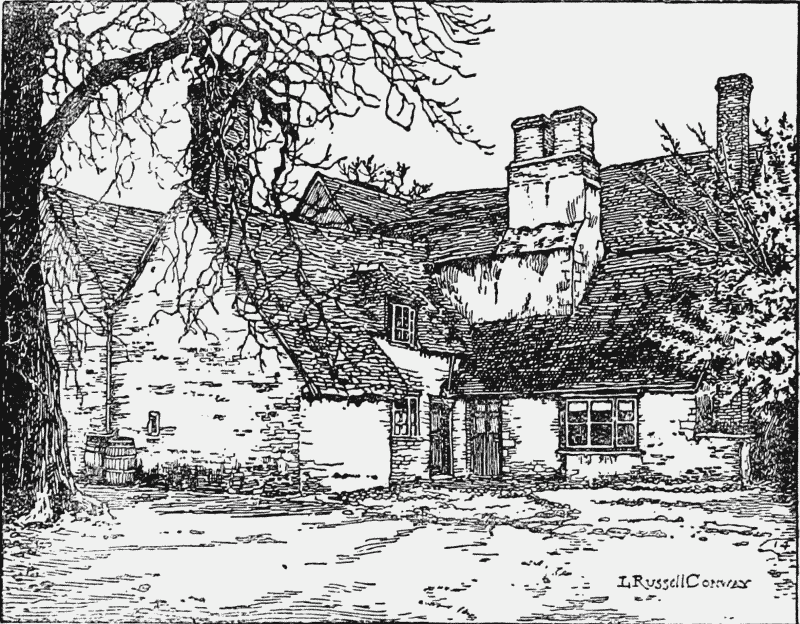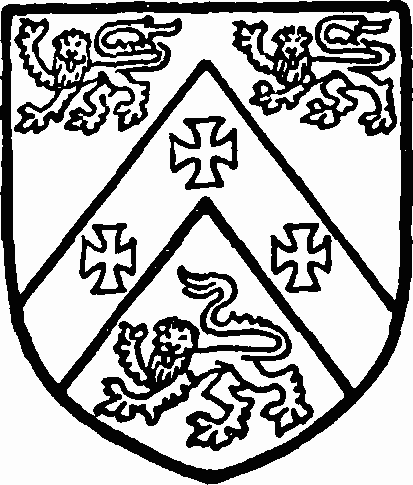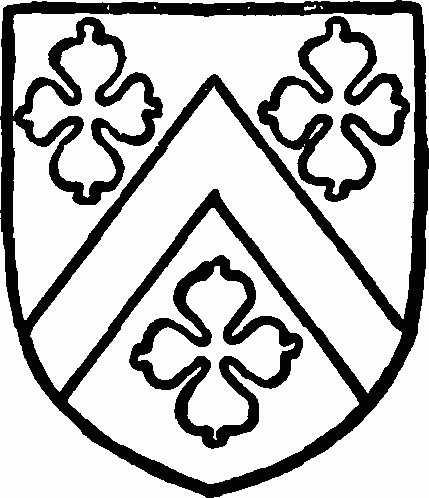A History of the County of Buckingham: Volume 4. Originally published by Victoria County History, London, 1927.
This free content was digitised by double rekeying. All rights reserved.
'Parishes : Water Stratford', in A History of the County of Buckingham: Volume 4, ed. William Page (London, 1927), British History Online https://prod.british-history.ac.uk/vch/bucks/vol4/pp260-263 [accessed 23 April 2025].
'Parishes : Water Stratford', in A History of the County of Buckingham: Volume 4. Edited by William Page (London, 1927), British History Online, accessed April 23, 2025, https://prod.british-history.ac.uk/vch/bucks/vol4/pp260-263.
"Parishes : Water Stratford". A History of the County of Buckingham: Volume 4. Ed. William Page (London, 1927), British History Online. Web. 23 April 2025. https://prod.british-history.ac.uk/vch/bucks/vol4/pp260-263.
In this section
WATER STRATFORD
Stradford (xi cent.); Stratforwe, Stratford, Straford, Westratforde (xiii–xv cent.).
Stratford did not acquire its present name until the 15th century, the first reference to Water Stratford occurring about 1436, after which date the name West Stratford seems to have been entirely lost. It is a small parish containing 1,102 acres, of which 763 are permanent grass and 235 arable land. (fn. 1) The soil is mixed clay, stone brash and gravel, and the subsoil Oolite. The land falls from about 400 ft. from the ordnance datum in the north to about 300 ft. in the south, where the Ouse forms the boundary, and is joined by a small stream from Stowe. The river is crossed four times by the Banbury branch of the London and North Western railway.
The main road from Brackley to Buckingham runs in a south-easterly direction through the parish, and on it is Water Stratford Lodge, one of the entrances to Stowe Park. Near by are Bear Bridge (fn. 2) and Ashmore Hole. Buffler's Holt is a small hamlet to the east. The 'small path,' a footway leading to the Ouse, is said to be part of an ancient street from Alcester and Bicester to Watling Street. (fn. 3) There are also said to be traces of a ford at 'Stollidge.' (fn. 4) In 1847–8, when digging for the railway viaduct, a number of Roman remains were found. (fn. 5)

Water Stratford Manor House
The village stands on a gentle slope above the river; it is picturesque, with irregular thatched cottages. The church of St. Giles is close to both river and railway, and adjoining the churchyard is the modern rectory-house. The manor-house is a large substantial stone building of two stories, with tiled roof. On a chimney-stack is the date 1598, which is probably the year in which the house was completed, but it appears to have been much altered about 1669, the date on a stone in the wall of an outhouse and on a doorway in the garden wall. In 1650 the house was worth £12 a year, built part with timber and part with stone and rough-cast, and covered with tiles, and consisted of hall, parlour, kitchen, several upstairs chambers, barns, stables and dovehouse. (fn. 6) In the garden traces of foundations have been found. (fn. 7)
The Town Farm, standing a little to the north of the church, is a 17th-century stone house with roofs of tiles, thatch, and slate.
The following place-names occur: Thadenham, Pukeput, (fn. 8) Prestewey, Hanedlond, Shaldambroch, Estmore (fn. 9) (xiii cent.); Pyper, Withesgrove, Mixbury Mead, Conyborough Mead (fn. 10) (xvii cent.).
There is no Inclosure Award for this parish.
Manor
In the reign of Edward the Confessor WATER STRATFORD was held by Azor son of Toti, who could sell it. After the Conquest it was granted to Robert Doyley, and in 1086 was assessed at 8 hides. (fn. 11) Robert died in 1090, his heir male being his brother Niel, who was succeeded on his death in 1112 by his son Robert Doyley. (fn. 12) This Robert founded the abbey of Oseney, (fn. 13) to which he gave two parts of the tithes of Stratford. (fn. 14) He died about 1150, and was succeeded by his son Henry, who died about 1168. (fn. 15) His son and successor Henry died without issue in 1232, his widow Maud marrying as her second husband William de Cauntelow, who before his death in 1238 was seised of a knight's fee in Water Stratford as part of his wife's dowry. (fn. 16) Maud died without issue about 1253. Henry Doyley's lands devolved on his nephew Thomas de Newburgh, sixth Earl of Warwick, (fn. 17) who paid relief for his lands in 1232. (fn. 18) He died without issue in 1242, and was succeeded in his estates by his sister Margaret, who in 1243 married John du Plessis. (fn. 19) Hugh du Plessis, son of John by a former wife, (fn. 20) in 1263 did homage for lands formerly belonging to Henry Doyley. (fn. 21) Hugh was overlord of Water Stratford in 1284–6, (fn. 22) and died in 1292, in which year his son Hugh had livery of his lands. (fn. 23) Hugh the younger granted some of his lands of the Doyley barony to Edward I in exchange, (fn. 24) and Water Stratford was perhaps included in this grant, for it was afterwards held by successive Princes of Wales till the overlordship lapsed after 1650. (fn. 25)
In 1086 Water Stratford was held of Robert Doyley by Turstin, (fn. 26) whose successors took their name from the place. William de Stratford (fn. 27) was holder of a knight's fee here about 1235, (fn. 28) and William lord of Stratford and William his son were witnesses to a deed in 1240. (fn. 29) About this time the 'park of Stratford' is mentioned. (fn. 30) William son of William de Stratford granted land here to Biddlesden Abbey early in the reign of Henry III. (fn. 31) In 1279–80 (fn. 32) and again in 1284–6 (fn. 33) William de Stratford was returned as holder of the vill of Water Stratford, comprising 8 hides, of which one hide was in demesne. Before 1302–3 (fn. 34) he had been succeeded by his son John, (fn. 35) who held in 1316 (fn. 36) and 1335. (fn. 37) He died before 1346, (fn. 38) leaving a widow Isabel (fn. 39) and three daughters, Elizabeth, Joan and Eleanor. (fn. 40) His successor, William de Stratford (son of John, son of John, son of John de Stratford), recovered seisin of the manor against Isabel in 1349. (fn. 41) His heir was his brother Thomas, (fn. 42) who before 1359 enfeoffed Sir John Giffard of Twyford, (fn. 43) probably as trustee. He is said to have settled the manor on himself, with remainder to Thomas Giffard (fn. 44) his son. (fn. 45) Roger son and heir of Thomas Giffard (fn. 46) was vouchee of the manor of Water Stratford in 1398, when it was claimed by Nicholas de St. Luke, Lucy Ikenam, and John de Stratford, descendants of the three daughters of John and Isabel de Stratford. (fn. 47) He was still seised of land here, held of John Giffard, on his death in 1409, (fn. 48) but that he no longer held the manor is further shown by the fact that his son Thomas Giffard still held 2 virgates of land on his death in 1469, (fn. 49) by which time the manor was in other hands. Before 1409 Thomas de Stratford had enfeoffed John Barton, sen., and John Barton, jun., of the manor. (fn. 50) John Barton, jun., in 1433 (fn. 51) enfeoffed trustees, (fn. 52) against whom in 1437 the descendants of two of John de Stratford's three daughters renewed their claim. (fn. 53)
From the Bartons the manor passed by enfeoffment before 1452 (fn. 54) to William Fowler of Lambard's Manor, Buckingham (fn. 55) (q.v.), with which it passed to his grandson Richard. He made a settlement of the manor in 1505, (fn. 56) and again in 1513 to the use of himself and his wife Julia with remainder to their son John, (fn. 57) who in 1533 conveyed it to his brother-inlaw, (fn. 58) Christopher Wescott of Ludgershall. (fn. 59) The latter sold it in 1546 to Sir Edward North, (fn. 60) who in turn conveyed it to William Humberston, reserving to himself £11 rent and also a payment of 4s. which had been made to Oseney Abbey. (fn. 61) In 1550 Humberston granted his interest to John Frayne, (fn. 62) who conveyed the manor in 1553 to John Frankish and Mary his wife. (fn. 63) John Frankish died in 1554, (fn. 64) and Mary held Water Stratford till her death. (fn. 65) Their son and successor Anthony in 1605 settled the manor on his wife Grissel and his eldest son Gerrard. (fn. 66) Anthony died in 1615, (fn. 67) and his son Gerrard died without issue before 1650. He was succeeded by his half-brother (fn. 68) Anthony Frankish, (fn. 69) whose daughter and heir probably married Thomas Edgerley. (fn. 70) Thomas Edgerley was succeeded in 1659 by his grandson Thomas Edgerley, (fn. 71) who in 1670 joined with his wife Frances and Anthony Frankish in a settlement of the manor. (fn. 72) Thomas Edgerley was Sheriff of Buckinghamshire in 1678. (fn. 73) In January 1698–9 he sold Water Stratford to Thomas Winford. (fn. 74) He was created a baronet in 1702, with special remainder to the heirs male of his brother, and died in the same year, (fn. 75) when he was succeeded by his nephew, Sir Thomas Cookes Winford, (fn. 76) who died without issue in 1744. He is said to have given this manor to his nephew Thomas Geers Winford, (fn. 77) of whose representatives it was bought by Benjamin Hayes before 1813. (fn. 78) His granddaughter Anne Frances, daughter of Treby Hele Hayes, (fn. 79) married William, son of William Mackworth-Praed, (fn. 80) and she held Water Stratford in her own right about 1862. (fn. 81) Their only child Anne Elizabeth married in 1857 Captain, afterwards RearAdmiral, George Parker and Water Stratford thus passed to that family. (fn. 82) Admiral Parker died in 1904 and was succeeded by his eldest son Major William Frederick Parker, (fn. 83) the present holder of the manor.

Fowler. Azure a cheveron argent between three leopards or with three crosses formy sable on the cheveron.

Winford. Argent a cheveron between three quatrefoils sable.
A mill worth 8s. yearly is mentioned in the Domesday Survey. (fn. 84) There was a water-mill on the demesne in 1278–9 (fn. 85) and a mill is mentioned as having been an appurtenance of the manor, but destroyed by Isabel de Stratford about 1349. (fn. 86)
A court leet and court baron were held by the lords of the manor in the 17th century. (fn. 87)
Church
The church of ST. GILES consists of a chancel, nave and western tower.
From the details surviving it would appear that there was a 12th-century church consisting of a chancel and nave. In the 13th century, probably after the grant of this church to Luffield Abbey, new windows were inserted in the chancel, and in the 14th century the tower was added or rebuilt. In the 15th century some repairs were made, and, probably about 1652, the date on a stone over the south door, new windows were inserted in the chancel and nave, including a dormer window on the south side. In the 18th century the tower was cut down and a porch of brick and timber added on the south side. (fn. 88) Excepting the tower, the church was practically rebuilt in 1828, but much of the old work was re-used. The church was again restored and altered in 1890.
The east window of the chancel is modern, but a plain 13th-century lancet has been re-used on the south side and another, which forms a low-side window, on the north. In the north wall is a fine reset 12thcentury doorway with a round head and a slightly recessed tympanum having a background of a diaper of roses upon which is a representation of the Agnus Dei. On the lintel are two dragons entwined. The chancel arch is of the 13th century and is of two moulded orders.
The nave is lighted by three windows. The eastern of the two in the north wall is of three lights with a round head, and the opposite window in the south wall is of the same character, but of two lights; both are probably of the early 19th-century restoration. The western window on the north, which is square-headed and of two lights, has re-worked 15thcentury tracery. The south doorway is a good example of 12th-century work. It has a semicircular head with zigzag ornament supported by plain columns with scroll-work capitals, billet-moulded abaci and moulded bases. The tympanum is carved with a Majesty having a kneeling angel on each side and the lintel is ornamented with interlaced arcading.
The 14th-century tower is now of two, but was originally probably of three, stages. The west window of the ground stage is of two lights with tracery under a pointed head. The tower arch is of two chamfered orders. The stair to the bell-chamber is in the southwest angle of the nave, which overlaps the tower. The bell-chamber has plain rectangular lights.
On the north wall of the nave is a monument to Mary wife of John 'Franckyshe' who died in childbed 6 January 1629–30. The monument represents a woman in bed, her husband at the foot and her two sons (Alexander and Anthony) and seven daughters (Grissel, Penelope, Avis, Elizabeth, Mary, Priscilla and Ann) standing round her, and a new-born infant in a cot. A stone in the churchyard commemorates Rev. Joseph Bosworth, D.D., the Anglo-Saxon scholar, who was rector of Water Stratford and died 27 May 1876 aged eighty-eight years.
There are three bells bearing the following inscriptions: treble, 'Marye Cornewell 1594,' by Bartholomew Atton; second, 'Pro Carolo Newsham hanc resono musam 1669,' by Richard Keene; tenor, 'Mary Cornwell gave mee 1632. New cast by H. Bagley 1717, Isaac Rushworth, rector, George Crow, C.W.' There is also a sanctus bell inscribed 'E. Hemins fecit 1736, William Fillpott, C.W.'
The plate consists of a silver cup and a plated flagon and plate, bought in 1837. There is a 17th-century wooden alms shovel.
The registers begin in 1596.
Advowson
The church of Water Stratford was given by William son of William de Stratford, to Luffield Priory, (fn. 89) and confirmed by Bishop Hugh of Wells in 1217. (fn. 90) The name of Ralph the rector here occurs about 1245. (fn. 91) In 1291 the rectory was valued at 5 marks (fn. 92) and at £8 at the Dissolution. (fn. 93) The advowson descended with Luffield Priory (q.v.) and with Stowe till about 1850, (fn. 94) when it appears to have been sold by the Duke of Buckingham. It passed to the Chawner family, from whom it was acquired about 1877 by W. J. D. Andrew. It was bought of his trustees in 1897 by the Rev. L. E. Goddard, the present patron and rector of the living. (fn. 95)
Robert Doyley (d. c. 1150) gave two parts of the tithes of Stratford to the abbey of Oseney, and the gift was confirmed by Henry III in 1267. (fn. 96) In 1291 the abbey held a portion of 20s. in this church (fn. 97) and had an annual payment of 6s. 8d. till the Dissolution. (fn. 98)
Dr. Robert Sipthorpe, presented to the rectory in 1616, was charged by Parliament with having caused the rupture between them and the king by preaching that the royal prerogative was above the law. (fn. 99)
Another rector was John Mason (d. 1694), 'an euthusiastic visionary' who believed he was Elias and appointed to proclaim the second Advent. He also declared that after his death he would rise again in three days. He had a large following who left their homes and filled all the houses and barns near Water Stratford. So great was their belief in his resurrection that his body had to be exhumed to prove his death. For some years after his death his followers continued to assemble at a place they called Holy Ground or at a house in Water Stratford. (fn. 100)
In 1325 John de Stratford had licence to grant land and rent in Water Stratford for a chaplain to celebrate divine service daily in the parish church there. (fn. 101) The advowson of the chantry at the altar of the Blessed Virgin Mary in the church of Water Stratford was in the hands of John de Stratford in 1335. (fn. 102) It is not afterwards mentioned.
Charities
Poor's Piece.—There was a piece of land, so called, containing about 5 a., much overgrown with bushes, which it was believed the poor had a right to cut for fuel, and an annual payment of £5, which was regarded as voluntary, was formerly made to the poor.